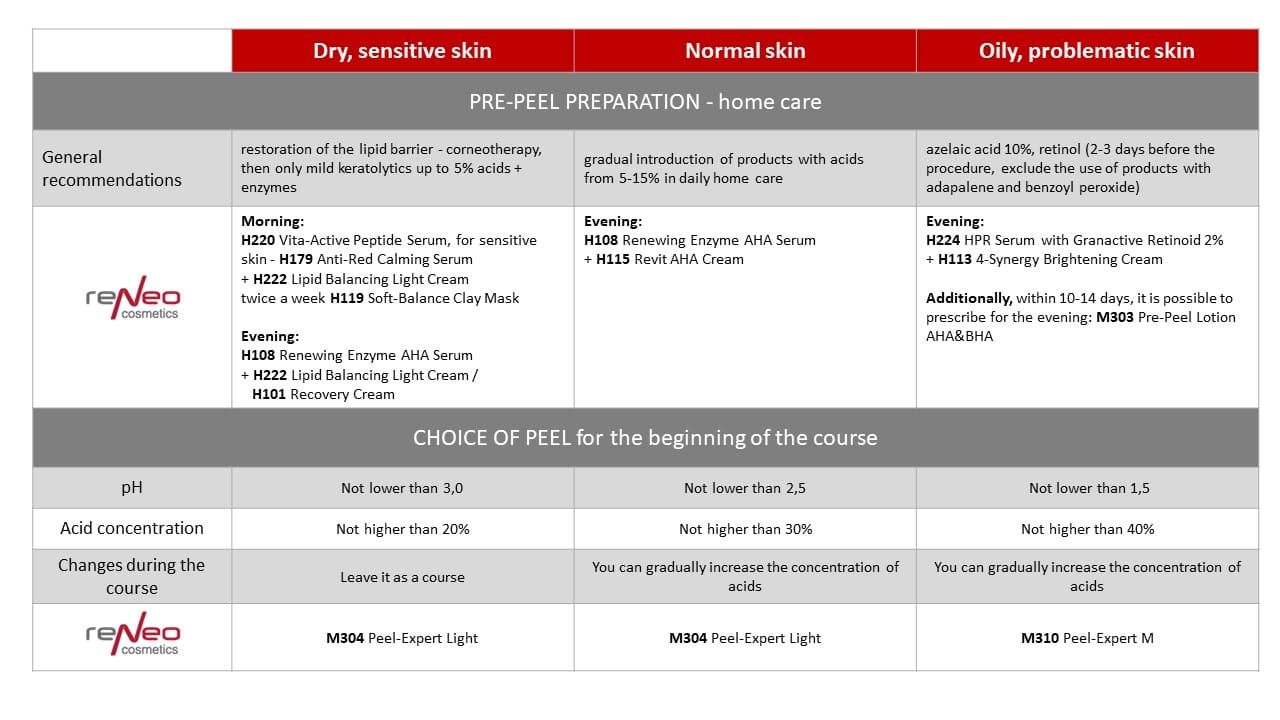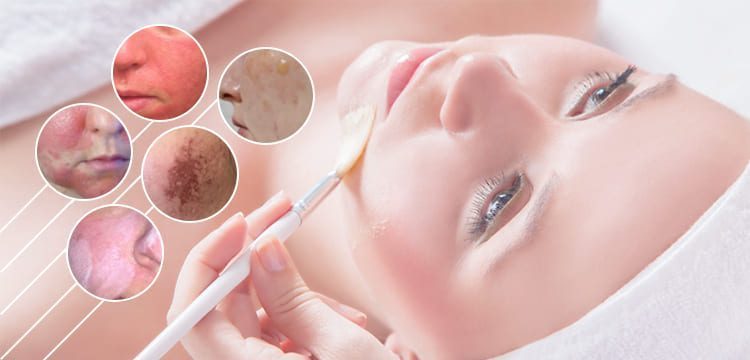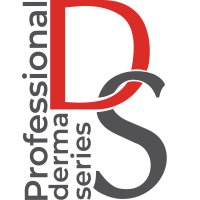A peel is one of the most popular procedures in cosmetology, aimed at improving the texture and color of the skin, fighting pigmentation, wrinkles and acne. However, despite its effectiveness, this procedure carries certain risks and can sometimes lead to undesirable consequences.
Peel procedure – possible negative skin reactions
The main task of a peel is controlled damage to the upper layers of the skin to stimulate its renewal. Superficial chemical peels work within the epidermis. Acid on the surface of the skin causes non-specific inflammation, which leads to the synthesis of chaperone proteins. The division of basal layer cells is stimulated, the regeneration process and the metabolic activity of cells are enhanced. Synthesis in lamellar granules increases, cytokines, neuropeptides, and prostaglandins are released.
When a peel is performed correctly, it provides a keratolytic effect, stimulates the maturation of new keratinocytes. The skin acquires a renewed, radiant appearance, gets tight, increases its turgor and tone.

However, if the peel is performed incorrectly, with a violation of the protocol, or if the individual characteristics of the client are not taken into account, the skin may react negatively. As a result, instead of renewing the skin, the peel procedure will lead to irritation, inflammation, and in the worst case – a chemical burn.
It is difficult to determine the line between “a peel is working” and the beginning of a chemical burn, so it is important to carefully monitor the skin’s reaction during the procedure. Do not leave the client for a moment!
What can trigger an overreaction of the skin to peels?
Probably, in the practice of every cosmetologist there was a moment when the skin reacted too actively to the “easiest” and safest peel or, even worse, received a chemical burn. What could be the reason?
An excessive reaction to peels can be triggered by a number of factors:
1. Maceration – when the patient’s skin shows signs of a damaged barrier even before the start of the procedure: areas with uneven skin surface, cracks (wings of the nose, nasolabial folds, areas with swelling), peeling, hyperemia
2. Incorrect choice of peels – different skin types require different concentrations of active substances. Using an overly aggressive composition on thin or sensitive skin can cause burns. If Peel-Expert Light is suitable for the most sensitive skin and is ideal for the beginning of any peel course, Peel-Expert Chroma is more active and recommended for use only from the second or third procedure of the course, when the skin is already prepared.
3. Violation of exposure time – prolonged exposure to peels increases the risk of deeper penetration of acids into the lower layers of the skin. For Peel-Expert peels, it is recommended to start the first procedure of the course with 3 minutes, and with each subsequent procedure, gradually increase the exposure time to 7-15 minutes, depending on the peel and the patient’s indications.
4. Insufficient pre-peel preparation – if the skin has not been properly prepared and has never been “acquainted” with acids or its barrier functions are weakened, the local immunity of the skin is reduced. This increases the likelihood of a negative reaction, the occurrence of a burn after a peel.
5. Ignoring contraindications – the presence of certain skin diseases (especially inflammatory dermatoses) or the use of certain drugs (hormones, antibiotics, retinol) can make the skin more vulnerable to peels. For example. if the patient undergoes a course of systemic or topical retinoids, the skin may have increased sensitivity, a weakened barrier, which leads to uncontrolled penetration of acids into the epidermis.
6. Recent aggressive procedures, in particular lasers, increase the likelihood of burns due to a decrease in local immunity, when subthreshold stress is perceived by the skin as another aggressive action.
How to determine a possible burn during the peel procedure?
Signs of an incipient burn may include:
- Frost
- Increasing hyperemia and strong burning sensations,
- Sudden pain,
- Intense redness,
- Appearance of blisters or swelling.
Edema indicates the increased permeability of the vascular wall and the release of plasma, which leads to intercellular edema of the skin, the release of eosinophils, and the appearance of itching.
Signs of an uncontrolled chemical burn will be pronounced hyperemia, the appearance of spilled frost (white layer), swelling of tissues, blisters and bubbles on the skin.
If the client complains of discomfort that exceeds the usual sensations from peels, the cosmetologist should immediately stop the procedure and start neutralizing the acid.
If you failed to notice the signs of a chemical burn in time during the procedure, they may, unfortunately, appear the next day. Red spots, a burning sensation that intensifies when in contact with water or other products – a post-peel chemical burn.
“Resuscitation” of the skin in case of a burn
If a burn does occur after a peel, it is important to take immediate action:
1. Neutralization. First of all, it is necessary to neutralize the remains of the peel: rinse thoroughly with cold water and then use the neutralizer. M311 Neutralizer from reNeo cosmetics additionally contains allantoin, which provides a soothing and regenerating effect. Then the skin should be thoroughly washed.
2. Removal of redness and inflammation of the skin. Apply products with soothing and restorative ingredients. In this case, it is very important to have Anti-Red Calming Serum in the office. This SOS remedy for all skin redness instantly soothes irritated skin. It blocks nerve endings in the dermis and the inflammatory reaction, reducing redness and swelling of the tissues. If necessary, you can repeat the product application 2-3 times. In addition, the Anti-redness serum has an active regenerating and moisturizing effect, strengthens the skin barrier, and significantly lowers the threshold of skin sensitivity to external irritations. If there are no cosmetic products, apply ordinary panthenol. In addition, you can take antihistamines.
3. Hydration and protection – It is important to provide the skin with intensive hydration and protection from external aggressive factors, including the sun. It is advisable to use products that do not require rinsing in order to avoid additional irritating skin contact with water. Ideal option – Hydra-Help Mask, restorative mask for maximum hydration: it cools tissues and increases cell hydration, helps reduce peeling after a peel and prevents skin dehydration.
The recommended sunscreen is Cream-Protector SPF30, which, in addition to protecting against the negative effects of UV rays, will stimulate the synthesis of heat shock proteins two to three times faster, thereby helping the skin to cope with stress.
4. Consultation with a doctor – In case of serious burns, if the competence of a cosmetologist is not sufficient, it is necessary to consult a dermatologist, who will prescribe the appropriate treatment.
5. Prescription of home care:
Exclude from skin care surfactants and irritating substances (acids, enzymes, mechanical granules) until the skin is completely restored
Avoid skin cleansing, make-up and minimize contact with water
During the first days, it is recommended to apply soothing, moisturizing agents during the day (for example, Anti-Red Calming Serum), and at night with a thick layer of Hydra-Help Mask (do not wash off).
Mandatory daily SPF protection when going outside – to protect the skin from possible post-peel peeling.
The first aid kit of any cosmetologist should always include:
- antihistamines
- hydrocortisone
- Panthenol
- local anesthetic – lidocaine
And the sos products mentioned above.
How to avoid negative skin reactions to peels?
You can avoid unpleasant consequences (or at least reduce the likelihood of their occurrence) by following the recommendations for pre-peel preparation and post-peel care.
Pre-peel preparation:
– Exclude the use of aggressive procedures (microdermabrasion, lasers).
– A few weeks before the procedure, it is recommended to use products with low concentrations of active acids or retinols to prepare the skin. A cream or serum with acid content is ideal, such as: 4-Synergy Brightening Cream Azelaic Acid 10%, Revit AHA Cream with glycolic acid 15% or serum with 5% glycolic acid and enzymes – Renewing Enzym AHA Serum.
– Analyze the condition of the skin, the presence of contraindications and carefully select an individual peel program for this patient. It is always better to start a course with gentle, delicate, revitalizing peels with a pH of 3.0 and above. The ideal start to any peel course – Peel-Expert Light Combi-peel for reactive skin – an all-season peel with instant results for revitalization, brightening and regeneration of the skin. This is a peel without downtime and it does not cause peeling.
Of course, pre-peel preparation should take into account the type and condition of the patient’s skin:
– dry sensitive skin – restoration of the lipid barrier – corneotherapy, then only mild keratolytics up to 5% acids + enzymes; starting peels with a pH not lower than 3.0 and a concentration not higher than 20%, leave it as a course
– normal skin – gradual introduction of products with acids from 5-15% in daily home care; starting peels with a pH not lower than 2.5, acid concentration not higher than 30%, it is possible to gradually increase the concentration of acids
– oily problematic skin – azelaic acid 10%, retinol (2-3 days before the procedure, exclude the use of products with adapalene and benzoyl peroxide); starting peels with pH not lower than 1.5, concentration of acids not higher than 40%, you can gradually increase the concentration of acids.

Post-peel care:
– After the procedure, the skin needs gentle care: you should avoid exposure to direct sunlight, use sunscreens, actively moisturize and protect the skin from pollution.
– It is not recommended to use decorative cosmetics in the first days after the peel, as well as aggressive cleansing agents (acids, mechanical abrasives).
Therefore, the absolute guarantee of a safe peel procedure is compliance with the protocol of the procedure: the correct choice of the drug, taking into account the client’s skin type and the time of action. Compliance with all recommendations and stages of the procedure minimizes the risk of complications and allows you to achieve the desired result without negative consequences.
Peaceful and effective peel procedures to you!



